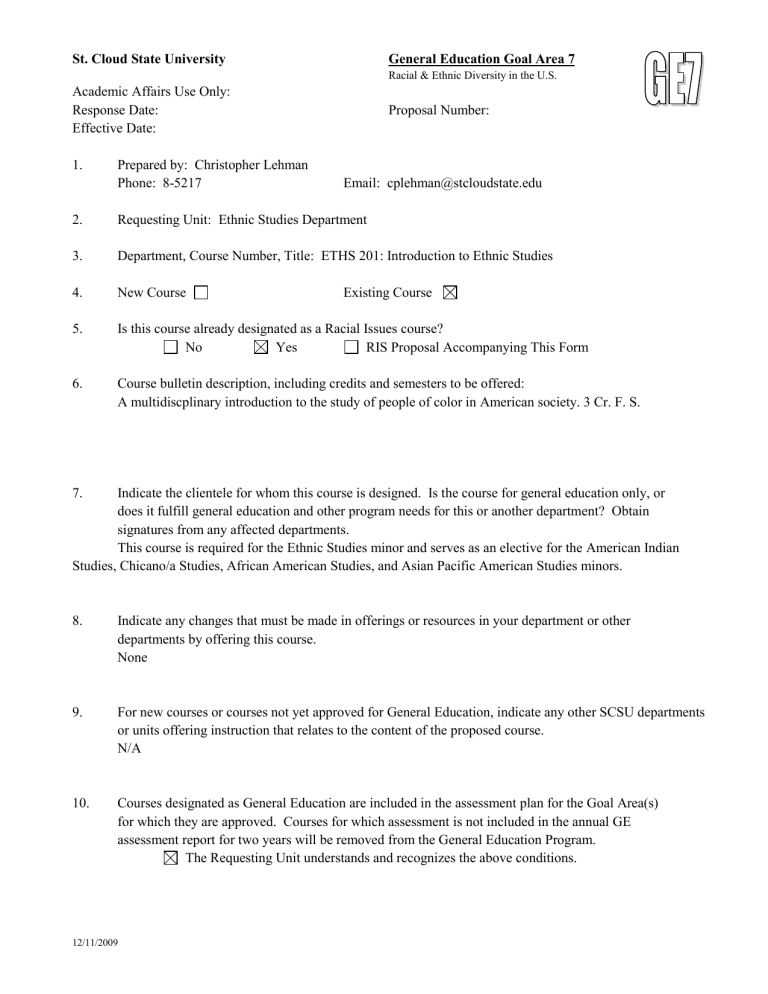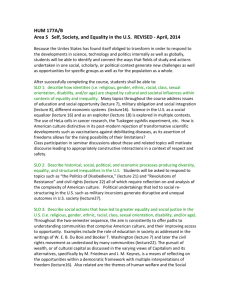GE-10-301 ETHS 201 Intro to Ethnic Studies Rev

2.
3.
St. Cloud State University
Academic Affairs Use Only:
Response Date:
Effective Date:
1. Prepared by: Christopher Lehman
Phone: 8-5217
General Education Goal Area 7
Racial & Ethnic Diversity in the U.S.
Proposal Number:
Email: cplehman@stcloudstate.edu
Requesting Unit: Ethnic Studies Department
Department, Course Number, Title: ETHS 201: Introduction to Ethnic Studies
4.
5.
New Course Existing Course
Is this course already designated as a Racial Issues course?
No Yes RIS Proposal Accompanying This Form
6.
7.
Course bulletin description, including credits and semesters to be offered:
A multidiscplinary introduction to the study of people of color in American society. 3 Cr. F. S.
Indicate the clientele for whom this course is designed. Is the course for general education only, or does it fulfill general education and other program needs for this or another department? Obtain signatures from any affected departments.
This course is required for the Ethnic Studies minor and serves as an elective for the American Indian
9.
Studies, Chicano/a Studies, African American Studies, and Asian Pacific American Studies minors.
8. Indicate any changes that must be made in offerings or resources in your department or other departments by offering this course.
None
For new courses or courses not yet approved for General Education, indicate any other SCSU departments or units offering instruction that relates to the content of the proposed course.
N/A
10. Courses designated as General Education are included in the assessment plan for the Goal Area(s) for which they are approved. Courses for which assessment is not included in the annual GE assessment report for two years will be removed from the General Education Program.
The Requesting Unit understands and recognizes the above conditions.
12/11/2009
12/11/2009
11. Provide a concise explanation of how the following goal is a “significant focus” of the proposed course.
Goal Area 7: Racial & Ethnic Diversity in the U.S.
Examine patterns of racial and ethnic inequality in the United States; the heritage, culture, and contributions of racially subordinated groups; and how race and ethnic relations are embedded in the institutions that structure our lives.
This course is designed to provide students with an overview of significant concepts related to the histories, societies, cultures and contributions of minority ethnic groups in the United States. By studying governmentally imposed policies of war, relocation, slavery, segregation and self-determination, a more accurate understanding of the unique political relationship between the U.S. government and minority ethnic groups will be gained. An examination of the social construction or race and ethnicity, racial oppression, discrimination and white privilege is examined as embedded in the social fabric of American life.
12. In order for a course to be designated as fulfilling Goal Area 7, it must address at least 5 of the 6 student learning outcomes (SLOs) below. Check the SLOs below that are focused on in the proposed general education course.
1. Demonstrate awareness and understanding of historical and current race relations in the United States.
2. Explain the concept of “race.”
3. Analyze current events and conditions at the local, statewide, and national levels using course theories and concepts.
4. Identify forms of institutional discrimination in areas such as education, media, housing, employment, economics, politics, and the legal system.
5. Describe the basic history of discrimination against and contributions of African Americans, Asian Americans,
American Indians, Latinos, and recent immigrants of color.
6. Engage in dialog and self-reflection concerning racism, racial oppression, and white privilege.
13. Discuss how each Student Learning Outcome checked above is achieved in this course. (Note: Although descriptions of typical assignments or types of assignments may be part of this discussion, it is not appropriate to submit copies of actual assignments.)
SLO1 is addressed when students study U.S. foreign and domestic policies that had direct impact on minority ethnic groups in the United States.
SLO2 is addressed when students study the development of theoretical concepts concerning ethnicity the United
States.
SLO3 is addressed when students examine the current practices of Affirmative Action, the fruit of the Civil
Rights Movement, and the state of local minority ethnic groups.
SLO4 is addressed when students discuss the current legacies of historic discrimination such as redlining and ethnic stereotyping.
SLO5 is addressed in the essay question of the final exam and the term paper on an issue concerning minority ethnic groups.
12/11/2009
14. List or attach the Course Outline (adequately described and including percentage of time to be allocated to each topic). Curriculum Committees may request additional information. Topics larger than 20% need to be broken down further. Indicate in your course outline where the Student Learning Outcomes checked above are being met.
Introduction and Vernacular- 20% - SLO 2, 5
African Americans - 20% - SLO 1, 3, 4, 5
Asian Pacific Americans - 20% - SLO 1, 3, 4, 5
American Indians - 20% - SLO 1, 3, 4, 5
Latinos/as - 20% - SLO 1, 3, 4, 5
12/11/2009
St. Cloud State University General Education Transmittal Form
Academic Affairs Use Only:
Response Date:
Effective Date:
Proposal Number
Department: Ethnic Studies Department
Course or Course(s): ETHS 201: Introduction to Ethnic Studies
Department or Unit Chair Signature
Department forward to Academic Affairs for publication and electronically to Chair of General Education Committee, Chair of College Curriculum Committee, College Dean
Approve
Recommendation of General Education Committee:
Disapprove
Date
Remarks:
Chairperson
Committee
Signature Date
Recommendation of University Curriculum Committee:
Chairperson
Committee
Approve Disapprove
Remarks:
Signature
Recommendation of Faculty Association:
Approve Disapprove
Date
Remarks:
FA Senate
Signature
Approve
Action of Academic Vice President:
Disapprove
Signature
Entered in Curriculum Data File
Date
Date
Remarks:
12/11/2009









